 |
 |
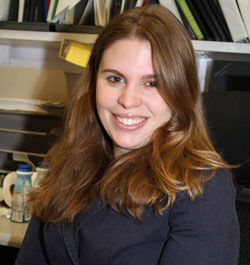
|
|
Tracy Doty, Medical Scientist (Neuroscientist), National Institute of Mental Health (NIMH), National Institutes of Health (NIH)
|
1. I chose this career because...
2. My typical workday involves...
3. What I like best/least about my work...
4. My career goals are...
5. When I'm not working, I like to...
|
|
1. I chose this career because...
|
Back to Top

|
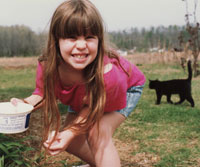
|
|
As child growing up in rural Alabama, Tracy had a pet goose and is pictured here collecting eggs.
|
I chose to become a medical scientist because I enjoy learning new things and helping other people. I grew up in rural Alabama and went to a Kindergarten through 12th grade school that had a total of 600 kids. Unfortunately, there were no opportunities for advanced students and I was often bored in my classes. Then I learned about the Alabama School of Mathematics and Science (http://www.asms.net/). It’s a selective residential school, funded by the state. It has an advanced program, where you spend your last 2 to 3 years of high school. Some classes are taught by college professors. This program gave me an opportunity to catch up and excel in the sciences. I believe it was why I was accepted into Duke University.
When I went to college, I thought I wanted to be a psychiatrist. After taking some psychology courses and learning about the biological basis of behavior, I realized that I liked the science aspects of psychology best. I knew I was a scientist at heart. Then I got a chance to work in several labs conducting research. In one cognitive neuroscience lab, the interactions between researchers were great. Even as an undergraduate student, my science mentors in the lab were interested in my ideas and respected them. My opportunities in research as an undergraduate student furthered my interest and encouraged me to continue my education in the field.
College Education
|
|
2. My typical workday involves...
|
Back to Top

|
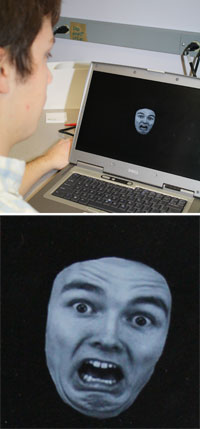
|
|
Tracy’s research volunteer views images of people with different facial expressions (top). Facial expression close up (bottom).
|
My typical workday revolves around my research project in the specialty of cognitive neuroscience. Studies show a person’s expectations change the way emotion and pain are perceived. For example, many people perceive pain when they get a shot. If they can change how they perceive that pain, like by thinking of something pleasant, they can change their emotions or experience for the better. The goal of the project then is to figure out how expectations affect perception and emotion. The results of my research could lead to new therapies for individuals with a mood disorder (e.g., anxiety, depression, post-traumatic stress disorder). People with mood disorders are challenged to change their perceptions and emotions in response to a certain experience.
My project involves working with human subjects who undergo brain scans while completing simple tasks. To do the brain scans, I use the Functional Magnetic Resonance Imaging (or FMRI) machine. These tests have to be scheduled in advance, as many other researchers at the NIH share this equipment resource.
Tasks for an MRI Scanning Day
- Set-up – Prepare the FMRI machine for scanning, complete necessary paperwork including permission forms for human subjects, and prepare sequence of tasks that will be performed by the test subject.
- Train the test subject – I teach my test subject how to do the tasks required on the computer (e.g., looking at fearful or neutral faces). Certain areas of the brain will become active depending on their emotional responses to what they are viewing, which we can capture with FMRI.
- Complete the imaging – Once subjects understand what they need to do, then the actual tasks can begin along with the imaging.
- Collect and analyze data – Images captured by the FMRI machine are saved into a computer database. After the test is complete, I collect the image data and begin analyzing the results with the help of specialized software programs.
Other Tasks
- Reading published research articles to stay up-to-date on current findings in cognitive neuroscience
- Attending presentations to learn about other major research findings by NIH colleagues
- Writing my research results in preparation for publication in a peer-reviewed journal
- Presenting my data to colleagues and other scientists
I also have served as a co-chair for the NIH Graduate Student Council ( http://gpp.nih.gov/Current/GraduateStudentCouncil/). The council serves as supporting resource for students associated with the Graduate Partnerships Program, http://gpp.nih.gov/). In this role, I oversaw the council activities and saw that its various committees were are running smoothly. I also wrote the constitution for the council.
|
|
3. What I like best/least about my work...
|
Back to Top

|
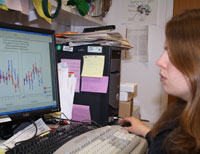
|
|
Tracy analyzes data collected by the Functional Magnetic Resonance Imaging (or FMRI) machine.
|
What I like best about my work is never finding an answer that ends the project. Every answer opens a new question.
What I like least about my work is that it can be frustrating, because I want to know everything. As scientists, there are always things we don’t know.
|
|
4. My career goals are...
|
Back to Top

|
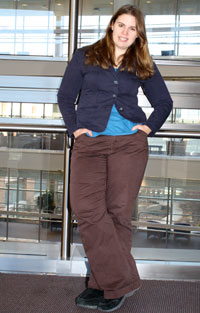
|
|
Tracey stands in the atrium of the NIH Clinical Center.
|
My career goals are to expand my work with clinical populations in the future, because I enjoy working with human subjects. My ultimate dream would be to become a principal investigator at an academic center with my own lab and a group of dedicated scientists helping me conduct my own research. I would also like to teach.
|
|
5. When I'm not working, I like to...
|
Back to Top

|
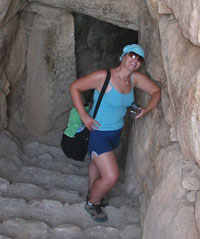
|
|
Tracy stands at the entrance to an ancient underground cistern, during a trip to Greece.
|
When I’m not working, I enjoy the outdoors and activities such as skiing, ice skating, hiking, and biking. I like to walk too, and walk 3 miles to and from work everyday. I also enjoy cooking. On occasion, I give a walking ghost tour for my friends around Washington D.C.
|
|
|
|
 |